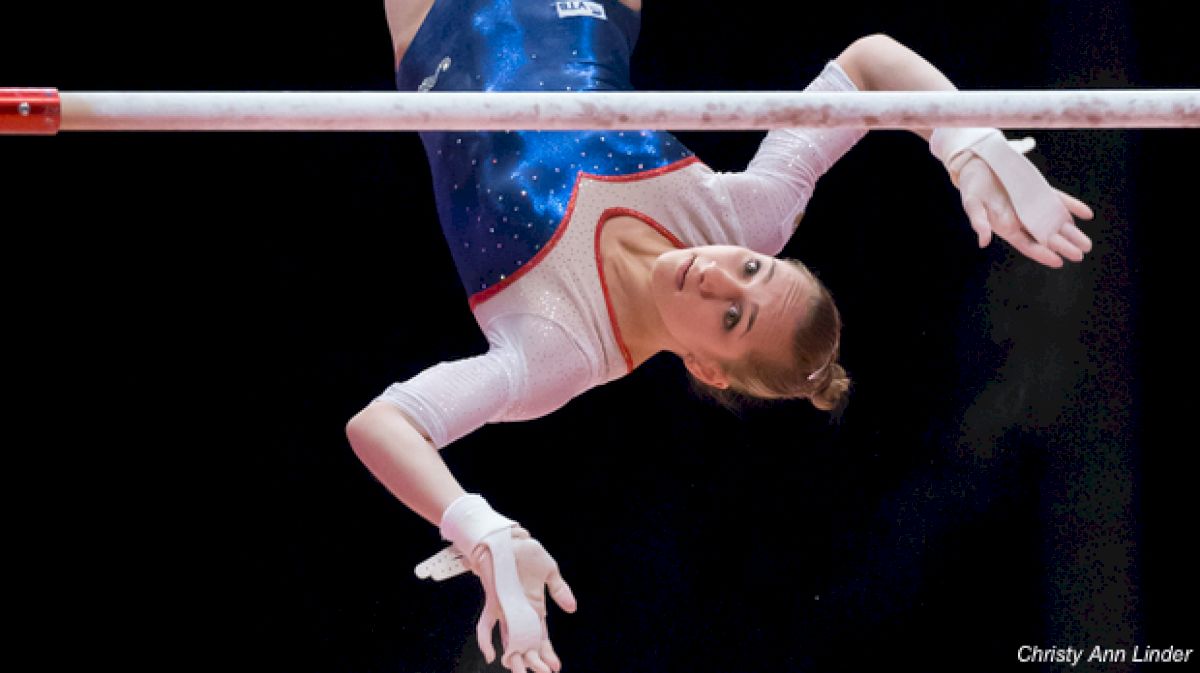What's The Difference: Untangling The Shaposhnikova Family
What's The Difference: Untangling The Shaposhnikova Family
Whether you’re a casual fan or a hard-core gymnastics nerd, gymnastics skills are confusing, but this new series on FloGymnastics helps you out.

What’s the Difference Between a Shaposh, Khorkina, Maloney, Van Leeuwen, Seitz, Chow, Chow Half, Komova, and Komova II?
Whether you’re a casual fan or a hard-core gymnastics nerd, let’s face it: Gymnastics skills are confusing. Nowhere is that more apparent than with uneven bars, where skills that look almost exactly the same have completely different names, difficulty levels, and idiosyncrasies.
Enter the Shaposhnikova family, one of the most important groups of skills in high-level gymnastics. Although the nature of the skills is the same — gymnast swings around the low bar and transitions to the high bar — the nuances between them are what makes bars routines so fun to watch. Here’s how to tell your Shaposh from a Khorkina, Maloney, Van Leeuwen, Seitz, Chow, Chow Half, Komova, and Komova II.
The Root Skill: The Shaposhnikova
Difficulty: D
The Shaposhnikova — or “Shaposh” for short — is named after the Soviet gymnast Natalia Shaposhnikova, who first completed the skill at the 1977 World Cup. It starts with a clear hip facing away from the high bar — and once the gymnast finishes the clear hip, she lets go of the low bar and uses the upward momentum to fly up to the high bar and catch it.
What differentiates the Shaposh from the other Shaposh-like skills are the entry (a clear hip, toe-on, stalder, or inbar) and the flight (no twist, half twist, or full twist). Let’s meet the Shaposhnikova sisters.
The Khorkina
Difficulty: E
The Khorkina was first performed by Russian gymnast Svetlana Khorkina at the 1996 Olympic Games. The skill starts with a clear hip — the same entry as the Shaposh — but the gymnast does a half turn in flight, finishing facing away from the low bar. That added half twist bumps up the difficulty from a D to an E.
The Maloney
Difficulty: D
The Maloney is named after the American gymnast Kristen Maloney, who first competed it at the 1997 World Championships. Instead of a clear hip, it begins with a toe-on entry — the gymnast pikes her legs and touches her toes to the bar as she circles around it — but like the original Shaposh, it has no twists. Naturally, the Maloney is also known as a Toe-On Shaposhnikova.
The Van Leeuwen
Difficulty: E
The Van Leeuwen is named for gymnast Laura Van Leeuwen from the Netherlands and was first competed at the 2004 Olympic Games. With a toe-on entry and a half twist in flight, it’s essentially a Maloney half, or a Khorkina with a toe-on instead of a clear hip.
The Seitz
Difficulty: E
The Seitz was debuted at the 2011 World Championships by German gymnast Elizabeth Seitz. Like the Maloney and the Van Leeuwen, it begins with a toe-on, but the gymnast does a full twist in flight, ending in a swing facing the low bar. Because transition elements are capped at an E-level difficulty, it has the same difficulty as the Van Leeuwen, even with that added half twist — making it one of the lesser-popular Shaposh-style skills.
The Chow (or Stalder Shaposhnikova)
Difficulty: D
The Stalder Shaposhnikova was first competed by American gymnast Amy Chow at the 1996 Olympics — and though it’s inexplicably not credited to her in the official Code of Points, it’s colloquially known as the Chow anyways. It begins with a stalder entry, in which the gymnast circles around the low bar in a straddled position before flying up to the high bar. Like the Shaposhnikova and the Maloney, it contains no twists.
The Chow Half (or Stalder Shaposhnikova 1/2)
Difficulty: E
The Stalder Shaposhnikova 1/2 is exactly what the name says it is: a stalder entry with a half twist in flight. It was first competed in 2006 and given a value in the Code of Points — but because it wasn’t done at a competition where a gymnast can get a skill named, it has remained technically nameless. Ironically, we simplify the name by calling it a Chow Half — despite the fact that the actual Chow isn’t in the Code of Points, either.
The Komova II
Difficulty: E
The Komova II was named for Russian gymnast Viktoria Komova, who first performed the skill at the 2011 World Championships. Instead of a clear hip, toe-on, or stalder entry, it begins with an inbar: a particularly difficult skill in which the gymnast pikes her legs deep enough so that her feet go below the bar as she circles it. (Gymnast Aliya Mustafina has joked that giving birth is easier than doing an inbar.) The Komova II has no twists — unlike the Komova, below — but because it was done after her first eponymous bars skill, it gets that “II.”
The Komova
Difficulty: E
The Komova is named for the same Viktoria Komova as the Komova II, after she performed it at the 2010 Youth Olympic Games. Like the Komova II, it begins with an inbar, but adds a half twist in flight, so that the gymnast is oriented away from the low bar when the skill is completed. Thanks to the pesky difficulty cap on transition elements, it has the same difficulty level as the Komova II, making it a not-quite-worth-it skill for most gymnasts.
Brette Warshaw is a freelance writer and consultant based in New York City. You can follow her at @bstarwarshaw.